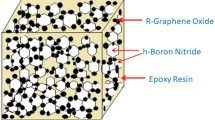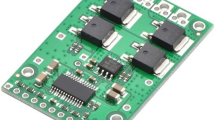Abstract
Thermal breakdown is the main form which leads to direct current (DC) cable accessories insulation invalid. In order to enhance the insulation of DC cable accessories, liquid silicone rubber (LSR) is improved by filling micron boron nitride (BN) to promote the dielectric properties and thermal conductivity in this paper. The electrical conductance, DC dielectric breakdown strength (DBS), dielectric spectrum and thermal conductivity of micro-BN/LSR composites with various filling concentrations are analyzed in combination with the charge-trap energy-level distributions by means of isothermal surface potential decay (ISPD) method. By filling micron BN into LSR, the insulation performance and thermal conductivity can be improved simultaneously, thus achieving a higher insulation reliability. When the concentration of BN micron-filler is increased to 40 wt%, the electrical conductivity can be reduced by three orders of magnitude compared with pure LSR, and the DC DBS and thermal conductivity rises by 52.82% and 141.38%, respectively, while the relative dielectric permittivity and dielectric loss are slightly increased. The ISPD analyses indicate that trap-level depth in BN/LSR composites can be further raised by increasing the concentration of BN micron fillers, thereby getting a higher DBS.











Similar content being viewed by others
References
Y. Li, T. Takada, Progress in space charge measurement of solid insulating materials in Japan. IEEE Electr. Insul. Mag. 10(5), 16–28 (1994)
T. Mizutani. High-voltage DC insulation and space charge. IEEE Conference on Properties and Applications of Dielectric Materials, Xi’an, (2000) pp. 18–23
F.K. Padgham, W.G. Lawson, P. Metra et al., The effect of polarity reversals on the dielectric strength of oil-impregnated paper insulation for HVDC cables. IEEE Trans. Power Appar. Syst. 97(3), 884–892 (1978)
B.X. Du, J. Li, Effects of ambient temperature on surface charge heat-shrinkable polymer under polarity reversal voltage. IEEE Dielectr. Electr. Insul. 23(2), 1190–1197 (2016)
C. Chuan, Research on Space Charge Test and Analysis Technology of High Voltage DC Plastic Cable (Shanghai Jiaotong University, Shanghai, 2009)
K.Y. Lau, M. Piah, Polymer nanocomposites in high voltage electrical insulation perspective: a review. Malays. Polym. J. 6(1), 58–69 (2011)
A. Samuel, S. Frank, O. Konstantin, Improved silicone rubber for the use as housing material in composite insulators. IEEE. Trans. Dielectr. Electr. Insul. 11, 209–217 (2012)
J.M. Yang, X. Wang, B.Z. Han, H. Zhao, M.Z. Xu, DC conductivity characteristic of LDPE nanocomposite and its effect on electric field distribution in HVDC cables. Proc CSEE 9, 1454–1461 (2014)
P.J. Baffles, S.K.L. Larkai, Liquid phase separation in pulsed DC fields. Chem. Eng. Res. Des. 60(2), 115–121 (1982)
M. Nagao, M. Kosaki, I. Sugiyama et al., Dielectric breakdown of polypropylene film in high temperature region. IEEE Int. Symp. Electr. Insul. Montr. 12(3), 182–185 (1984)
L. Ziyu, Principles of Electrical Insulating Structure Designing (China Machine Press, Beijing, 1981), pp. 183–188
Z.H. Li, L.L. Liu, H. Zheng, Simulation on the influence factors of electric field distribution in HVDC cable. Proc. CSEE 36(9), 0258–8013 (2016)
Z. Ye, C. Junwei, W. Sizhen et al., Development and prospect of high voltage DC cable insulation materials. Insul. Mater. 49(2), 1–7 (2016)
Z.M. Dang, H.Y. Wang, L. Wang, New inorganic/organic functional composites with high temperature and high dielectric constant. Acta Mater. Compos. Sin. 22, 9–15 (2005)
J.D. Wu, Y. Yin, L. Lang et al., The influence of nano-filler concentration on space charge behavior in LDPE/silica nanocomposites. Proc. CSEE 32, 177–183 (2012)
L. Lv, X. Wang, H.Q. He et al., Formation of space charges at interface between ethylene propylene diene terpolymer and silicone rubber. Proc. CSEE 27, 106–109 (2007)
D. Weida, T. Steinmetz, M. Clemens, Electro-quasistatic high voltage field simulations of large scale insulator structures including 2-D models for nonlinear field-grading material layers. IEEE Trans. Magn. 45, 980–983 (2009)
W. Jiajun, Y. Xiao-Su, Effects of interfacial thermal barrier resistance and particle shape and size on the thermal conductivity of A1N/PI composites. Compos. Sci. Technol. 64(10–11), 1623–1628 (2004)
S. Kemaloglu, G. Ozkoc, A. Aytac. Properties of thermally conductive micro and nano size boro nitride reinforced silicon rubber composites. Thermochim. Acta 499(1–2), 40–47 (2010)
M. Ying. Preparation and Properties of Thermal Insulation Silicone Rubber Composites. Master’s Thesis of Tianjin University, 2012
Z. Chen Zhengzheng, Z. Peng, Jianjian et al., Development and prospect of DC cable transmission at home and abroad. Glob. Energy Internet 1(4), 487–495 (2018)
J. Wang, L. Yanzhuo, G. Fei et al., The key technology of XLPE high voltage DC cable accessories installation Electron. Technol. Softw. Eng. 17, 225–226 (2018)
L. Du Boxue, Z.Y. Zhuoran et al., Application and research progress of HVDC cross-linked polyethylene cables. High Volt. Technol. 43(2), 344–354 (2017)
Y. Yin, D.M. Xiao, D.M. Tu, An application of space charge invaliding the electric aging degree of insulating polymer. Proc. CSEE 22, 43–48 (2002)
X. Cheng, S.Q. Cheng, X. Wang et al., Effect of nano ZnO on space charge distribution in polyethylene during corona aging. Insul. Mater. 41, 44–48 (2008)
S.T. Li, G.L. Yin, G. Chen, J.Y. Li, S.N. Bai, L.S. Zhong, Y.X. Zhang, Q.Q. Lei, Short-term breakdown and long-term failure in nanodielectrics: a review. IEEE Trans. Dielectr. Electr. Insul. 17, 1523–1535 (2010)
S.T. Li, G.L. Yin, S. Bai, J.Y. Li, A new potential barrier model in epoxy resin nanodielectrics. IEEE Trans. Dielectr. Electr. Insul. 18, 1535–1543 (2011)
X. Li, Study on Surface Charge Accumulation and Breakdown Mechanism of Oil-Immersed Paper in the Side Bushing of Uhv Converter Transformer Valve (Tianjin University, Tianjin, 2017), pp. 28–31
Funding
Project Supported by the National Key Research and Development Program of China (2017YFB0902704); Project Supported by the National Natural Science Foundation of China (51677046); National Natural Science Foundation of China (51877056); University Nursing Program for Young Scholars with Creative Talents in Heilongjiang Province (UNPYSCT-2016159).
Author information
Authors and Affiliations
Contributions
Conceptualization, QC; formal analysis, BX and JZ; Investigation, BX and QC; resources, QC; data curation, BX and XW; writing—original draft preparation, BX and HY; writing—review and editing, BX and MC; supervision, QC; project administration, M.C.
Corresponding author
Ethics declarations
Conflict of interest
The authors declare no conflict of interest.
Additional information
Publisher's Note
Springer Nature remains neutral with regard to jurisdictional claims in published maps and institutional affiliations.
Rights and permissions
About this article
Cite this article
Chen, Q., Xi, B., Zhang, J. et al. Dielectric properties and thermal conductivity of micro-BN-modified LSR used for high-voltage direct current cable accessories. J Mater Sci: Mater Electron 31, 16583–16591 (2020). https://doi.org/10.1007/s10854-020-04213-w
Received:
Accepted:
Published:
Issue Date:
DOI: https://doi.org/10.1007/s10854-020-04213-w




